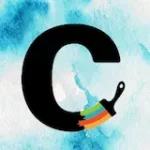Knowing how to promote an event isn't just about what you post on social media. The real magic happens long before that. A truly successful promotion is built on a solid strategic foundation—one that nails down who you're talking to, clarifies why your event is a can't-miss, and sets goals you can actually measure.
This initial planning stage is what separates a focused, effective campaign from just making noise online. It's how you get the right people in the room.
Build Your Foundation for a Sold-Out Event
Before you even think about selling a single ticket or drafting an email, the most critical work happens behind the scenes. This is where you trade wishful thinking for a concrete strategy. Think of it as creating a blueprint that ensures every single promotional effort is intentional, targeted, and tied directly to a real outcome.
Jumping straight into tactics without a plan is like building a house with no foundation. It might stand for a minute, but it's bound to fall apart. The whole point here is to make your event feel completely essential to your audience.
Define Your Ideal Attendee
Who are you really trying to reach? Just knowing their age and job title isn't enough. You need to dig deeper and build a detailed attendee persona that gets into their motivations, their biggest challenges, and where they hang out online.
Ask the right questions to uncover the good stuff:
- What are their biggest professional or personal pain points? Knowing this lets you frame your event as the exact solution they've been looking for.
- Where do they spend their time online? This tells you if you should be all-in on LinkedIn, Instagram, niche forums, or specific industry newsletters.
- What kind of content do they actually pay attention to? Do they love short-form video, deep-dive articles, or podcasts? This will shape your entire content plan.
For example, promoting a local graphic design workshop isn't just about targeting "designers." Your ideal attendee might be a freelancer who's struggling to land high-paying clients. Or maybe it's a marketing manager who needs to get their team's design skills up to snuff. That distinction changes everything.
Craft a Compelling Value Proposition
Once you know who you're talking to, you can answer the most important question from their perspective: "Why should I bother attending?" Your event's value proposition needs to be a clear, punchy, and compelling statement that screams unique benefits. It’s not just about what your event is, but what it does for them.
A weak value proposition is generic fluff like, "Join our annual tech conference." A strong one is specific and hits on a real benefit: "Connect with top-tier VCs and learn the exact framework that took three startups to IPO." A strong value proposition is the core of your event's identity. If you need a hand sharpening yours, check out our guide on how to build a strong brand identity.
Set Clear and Measurable Goals
What does a "win" actually look like for your event? Fuzzy goals like "increase awareness" are impossible to track and don't mean much. Instead, you need to set SMART goals (Specific, Measurable, Achievable, Relevant, Time-bound) that will act as the guide for your entire campaign.
Before you launch, you should be able to fill out a simple checklist like this to make sure your strategy is sound.
Event Promotion Planning Checklist
| Planning Component | Key Question to Answer | Example |
|---|---|---|
| Ideal Attendee | Who are we trying to reach, beyond basic demographics? | "Freelance graphic designers with 2-5 years of experience who struggle with client acquisition." |
| Value Proposition | What unique, tangible benefit will they get from attending? | "Learn our 5-step system to double your freelance rates in 90 days." |
| Primary Goal | What is the single most important metric for success? | "Sell 250 tickets by August 31st." |
| Secondary Goals | What other measurable outcomes are we aiming for? | "Generate 100 qualified leads for our premium coaching program and gain 500 new email subscribers." |
| Key Channels | Where will we focus our promotional energy for the best ROI? | "Instagram (Reels & Stories), LinkedIn (organic posts & targeted ads), and our weekly email newsletter." |
| Budget | How much are we allocating to paid promotion and other expenses? | "$5,000 total: $3,000 for social media ads, $1,000 for influencer outreach, $1,000 for content creation." |
Having this level of clarity turns your promotion from a guessing game into a well-oiled machine.
Key Takeaway: Your promotional goals are your North Star. Every tactic, from social media posts to email campaigns, should be evaluated based on how effectively it contributes to achieving these specific objectives.
Here are a few examples of strong, measurable goals in action:
- Sell 300 early-bird tickets by May 15th.
- Achieve a 25% conversion rate on the event landing page.
- Secure 500 new email subscribers through our pre-event webinar.
This strategic groundwork is absolutely essential. The global events industry was valued at around $736.8 billion in 2021 and is on track to hit $2.5 trillion by 2035. That massive growth means more noise and more competition. A sharp, well-defined strategy is your best weapon.
Create Your Digital Promotion Hub
Alright, with your game plan locked in, it's time to build your event's digital headquarters. This isn't just another page on your website; it’s the central hub for everything related to your event, designed from the ground up to turn casual interest into actual registrations.
Think of it as the single source of truth. Schedule, speakers, ticket links—it all lives here. When your promotional efforts are scattered across a dozen platforms, you just end up confusing people and tanking your sign-ups. By funneling everyone to one optimized spot, you create a super clear path for your audience to follow.
Crafting a High-Converting Event Landing Page
Your event landing page is easily your most important promotional tool. Period. Its only job is to convince visitors to register, so every single element needs to push them toward that "sign up" button. A great landing page doesn't just inform; it's a powerful sales tool that does the heavy lifting for you.
It’s basically your ultimate event brochure, but it's interactive and built for action. Take a look at this layout—it immediately puts the value prop and call-to-action right where you can see them.
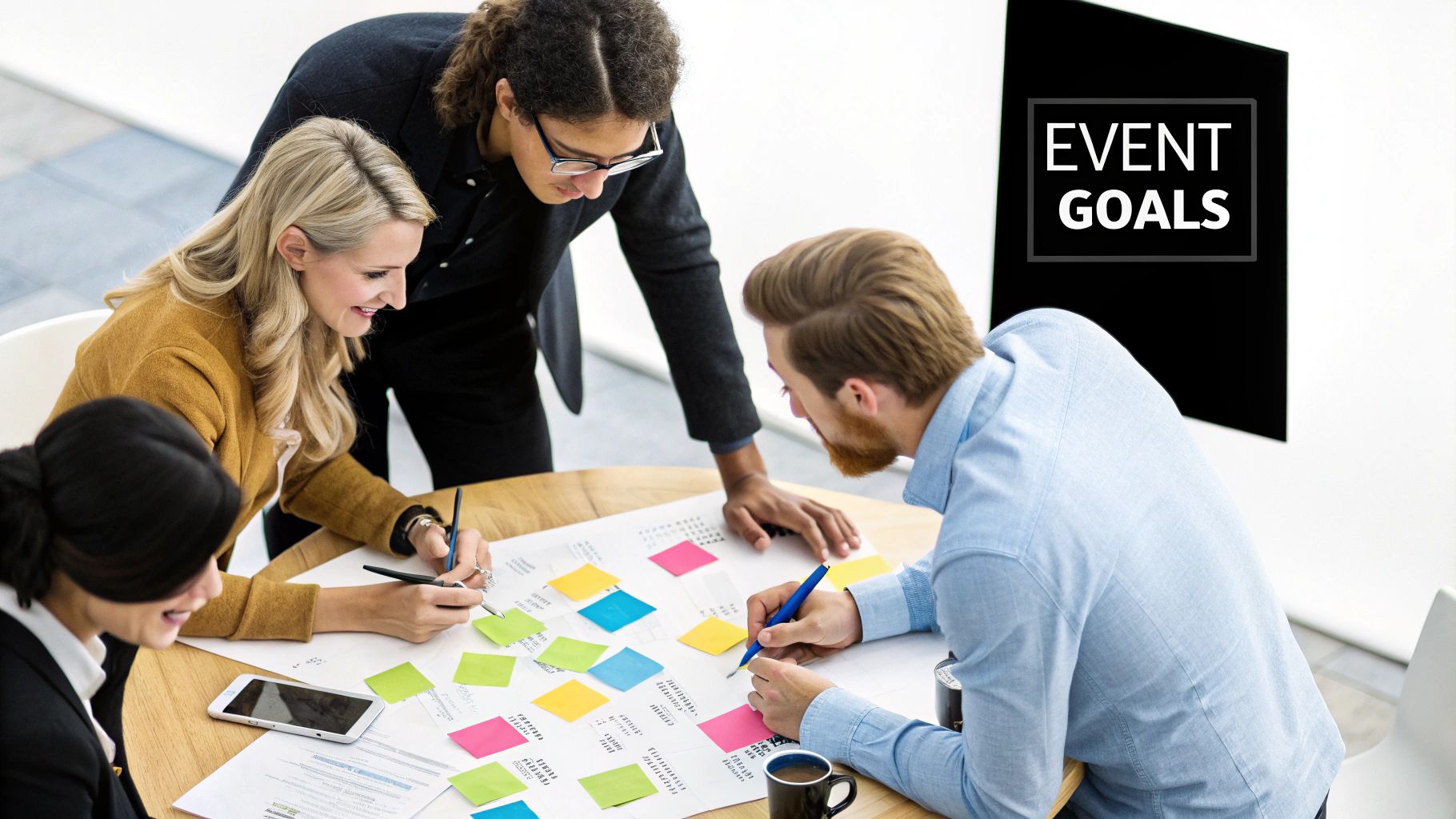
This example nails how critical elements—a killer headline, a clear sub-headline, and a big, obvious CTA button—can work together to grab someone's attention the second they land on the page.
To build a page that actually converts, you need to get these components right:
- A Headline That Pops: Grab their attention with a benefit-driven headline. Answer their silent question: "What's in it for me?"
- Clear Value Proposition: Quickly tell them who the event is for, what problem it solves, and why they absolutely can't miss it.
- The 5 Ws: Don't make them hunt for info. Clearly state the Who (speakers), What (agenda), When (date/time), Where (venue or virtual link), and Why (the big benefits).
- Real Social Proof: Nothing builds trust like testimonials from past attendees, logos of your sponsors, or impressive quotes from speakers.
- Frictionless Registration: Make buying a ticket or signing up ridiculously easy. Ditch any unnecessary form fields and make that CTA button stand out.
If you’re looking at your current website and thinking it’s not quite up to the task, it might be time for an upgrade. Our comprehensive website redesign checklist can walk you through getting your digital home ready to drive some serious promotional results.
Develop a Content Calendar to Build Anticipation
A slick landing page is useless if no one sees it. That’s where a smart content calendar comes into play. Instead of just dropping random announcements, a well-planned calendar lets you build a real narrative around your event, creating a steady drumbeat of excitement that grows over time.
This turns your promotion from a simple announcement into a full-blown, engaging campaign. It keeps your audience hooked and gives them plenty of reasons to keep coming back to your landing page and, you guessed it, register.
Pro Tip: Your content needs to do more than just announce. It should offer real value, create a serious case of FOMO (Fear Of Missing Out), and start building a community long before the doors even open.
Start by mapping out your content across different channels for each phase of your promotion.
Pre-Launch Content Ideas
- Speaker Spotlights: Share Q&A blog posts or short video interviews with your speakers. It positions them as the experts they are and gives a little tease of what their session will cover.
- Behind-the-Scenes Sneak Peeks: Post short clips of the venue being set up, your team in a planning huddle, or even a shot of the swag bags being prepped. This makes the event feel real and tangible.
- Countdown Posts: Use Instagram Stories and other social posts to build urgency as the big day gets closer. Everyone loves a good countdown.
- Benefit-Focused Carousels: Create those super-shareable graphics that break down the top 3-5 reasons someone needs to be there. Focus on outcomes, like "Master a new skill" or "Network with industry leaders."
By mixing up your content, you give people multiple ways to connect with your event. This sustained effort keeps you top-of-mind, drives a constant flow of traffic to your digital hub, and gives you the best shot at a sold-out success.
Alright, your strategy is locked in and your event hub is live. Now comes the fun part: actually getting the word out and bringing your plan to life.
This is where the rubber meets the road. You’re actively reaching out to potential attendees across all the channels that matter. Success here isn’t about shouting from every rooftop; it's about being smart and showing up where your audience is already hanging out. A multi-channel push creates a surround-sound effect, reinforcing your message from different angles and building the kind of momentum that turns casual interest into ticket sales.
Social Media That Actually Connects
Just blasting your event flyer across all your social profiles is a surefire way to get ignored. Every platform has its own vibe, its own language. To really make a mark, you have to create content that feels like it belongs there.
Think about it. Instagram is all about visuals and energy. LinkedIn is for professional value. Facebook is the community hub.
- Instagram Reels: Show off the behind-the-scenes chaos, grab a speaker for a quick 30-second interview, or post a slick countdown graphic. Keep it fast, fun, and exciting.
- LinkedIn Articles: Have one of your keynote speakers write a short, sharp article on a topic they’re passionate about—something related to their session. You’re giving away value first, which makes the promotion feel earned.
- Facebook Events: This is non-negotiable. Set up an official event page. It becomes the central spot for RSVPs, updates, and fielding questions from curious attendees.
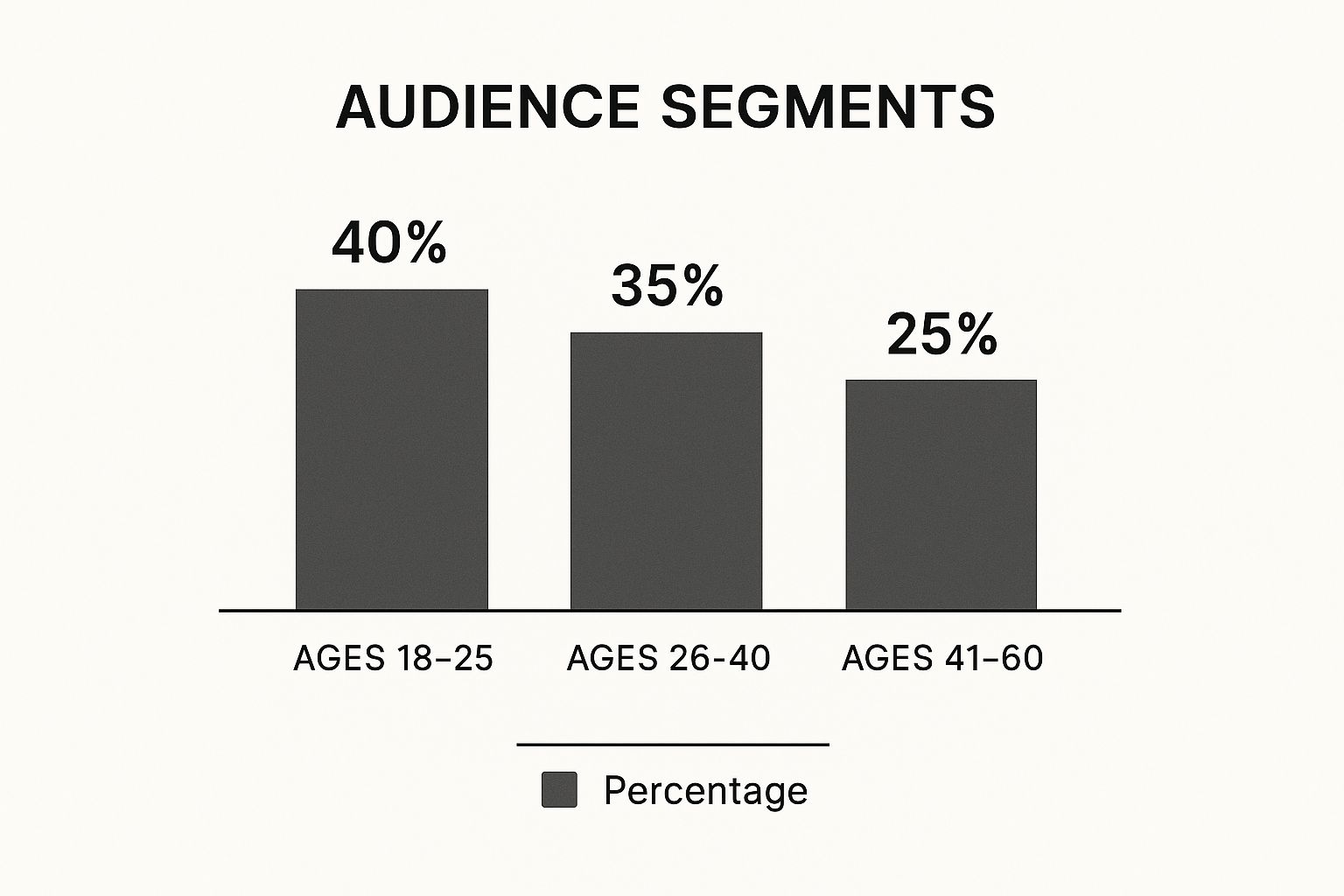
This kind of data is gold. For a community tech event like this, it tells you a story. You absolutely need a strong game plan for Instagram and TikTok to hit that huge younger demographic, but you can't forget LinkedIn if you want to capture the seasoned professionals.
Use Email to Guide, Not Just Announce
Let's be clear: email is still a beast for event promotion. It’s your direct line to people who have already opted in. But the days of the generic email blast are long gone. The real magic happens when you segment your list and send targeted messages that tell a story.
Think of your email sequence as a journey you’re taking your subscribers on.
Start with an initial announcement, but make it special. Give your most loyal followers a heads-up first, maybe with an exclusive early-bird code as a thank you.
Next, shift into value-driven nurturing. Send emails that spotlight specific speakers, dive deep into a can't-miss session, or highlight a unique networking opportunity. You're constantly reminding them why this event is worth their time and money.
As the date gets closer, it's time to introduce a little urgency and scarcity. A "Last Chance to Save" email before a price jump or a "Just a few spots left!" message can be the final nudge someone needs to hit "register."
A great email campaign doesn't feel like a sales pitch. It feels like a helpful guide, laying out all the compelling reasons why your event is the one they can't afford to miss this year.
Before we dive into tactics, let's look at how different channels stack up for event promotion. Each one has its strengths, and knowing how to play to them is key.
Promotional Channel Strengths and Tactics
| Channel | Primary Strength | Example Tactic |
|---|---|---|
| Social Media | Building hype and community engagement | Host a live Q&A with a keynote speaker on Instagram. |
| Email Marketing | Direct communication and conversion | Send a segmented email offering a special discount to past attendees. |
| Partnerships | Extending reach and borrowing credibility | Provide speakers with a "promo kit" of graphics and copy to share with their network. |
| Paid Ads | Targeted audience reach and retargeting | Run Facebook ads targeting users who visited your event page but didn't register. |
| Content Marketing | Providing value and demonstrating expertise | Publish a blog post summarizing the top 5 trends your event will cover. |
| Local Outreach | Tapping into the immediate community | Distribute flyers at local co-working spaces, cafes, and universities. |
Choosing the right mix from this table depends entirely on your specific event and audience. A local workshop will lean heavily on local outreach, while a global virtual summit will go all-in on paid ads and content marketing.
Turn Your Partners into a Promotion Army
You don’t have to do all the heavy lifting yourself. Your speakers, sponsors, and partners have their own audiences who trust them. They can be a massive extension of your marketing efforts—if you make it incredibly easy for them to help.
This is where a dedicated "partner toolkit" comes in. Pack it with everything they could possibly need.
- Pre-written social posts they can just copy and paste.
- Branded graphics and banners perfectly sized for different platforms.
- A unique tracking link so they can see the sign-ups they've driven. This is a game-changer for affiliate-style deals.
Bringing industry voices into your corner can completely change the game. This is why tactics like influencer marketing for events are so powerful. Influencers bring built-in trust and can introduce your event to a highly engaged community overnight. If you're looking for more ways to leverage your network, these small business marketing resources are a great place to start.
Get Media Mentions for Powerful Credibility
Getting a shout-out from a relevant blogger, an industry publication, or a local news outlet is pure gold. It’s one thing for you to say your event is amazing; it's something else entirely when a trusted third party says it.
But effective media outreach isn't about spamming every reporter you can find. It's about relationships.
Start by identifying the journalists and bloggers who actually cover your niche or your city. Follow them, engage with their work, and show them you’re paying attention before you ever pitch them. When you finally do reach out, make it personal. Explain exactly why your event is a story that their specific audience would care about. This thoughtful approach cuts through the noise and gets results.
Amplify Your Reach with Paid Advertising
Organic promotion is great for building a solid foundation, but let's be real—sometimes you need to get your event in front of the exact right people, right now. That's where paid advertising comes in. It's your superpower.
Paid ads move you from just hoping your ideal audience sees your content to strategically placing it right in their feeds. This is how you scale your promotion and make sure every single marketing dollar is pulling its weight. Think of it as the difference between casting a wide, hopeful net and using a laser-guided system to find your future attendees on platforms like Facebook, Instagram, and LinkedIn.
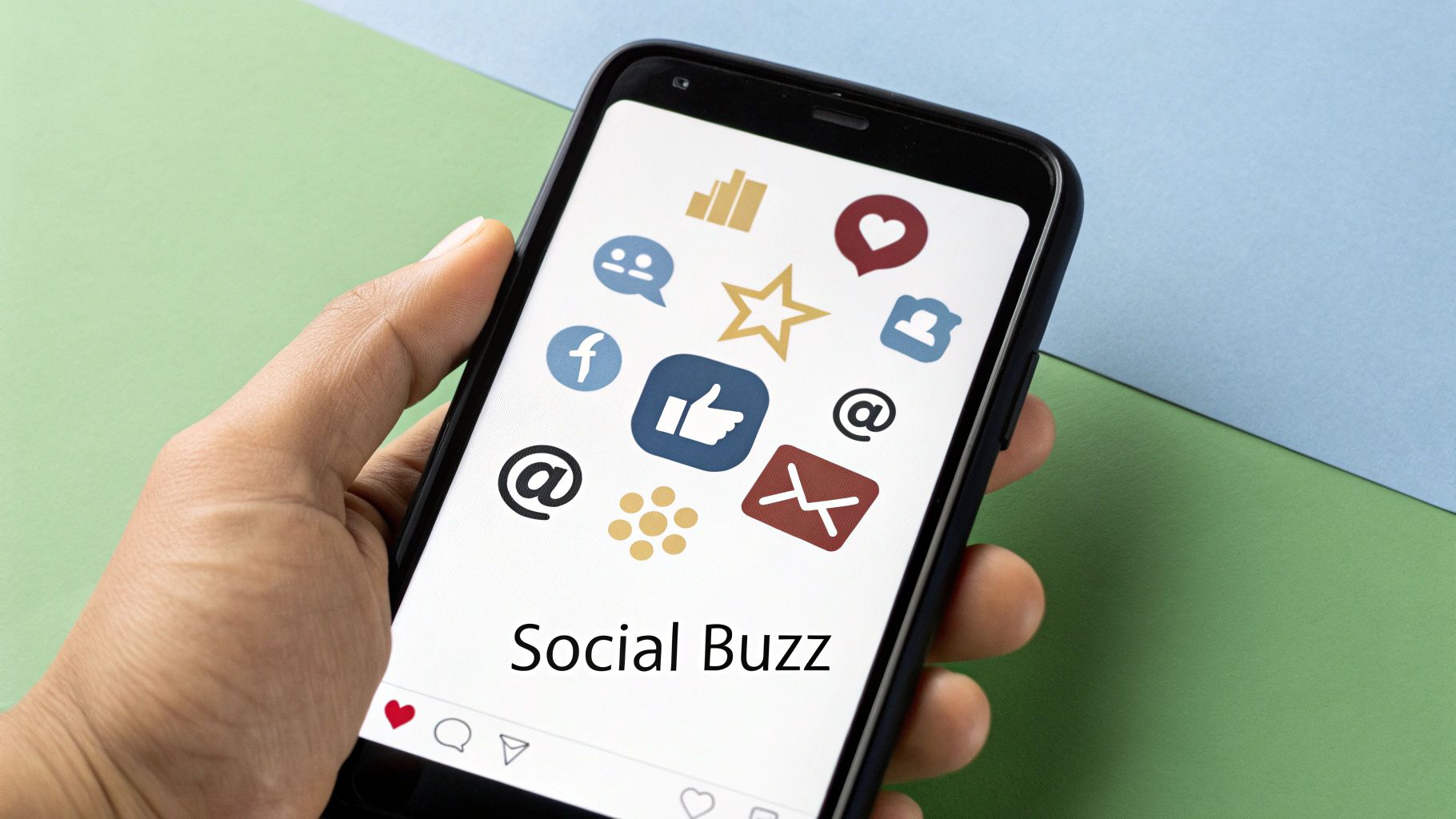
Go Deep with Granular Audience Targeting
The real magic of paid ads isn't just about reaching more people; it's about the incredible targeting capabilities. You can go way beyond broad demographics and build audiences based on specific behaviors, job titles, and niche interests. This makes your ad spend hyper-efficient.
Let's say you're promoting a B2B marketing conference. Instead of just targeting "marketers," you could jump on LinkedIn and create a super-specific audience of people who are:
- Job Title: "Marketing Manager," "Director of Demand Generation," or "CMO."
- Company Size: Working at businesses with 50-200 employees.
- Industry: Software as a Service (SaaS).
This kind of detail ensures your ads are hitting the decision-makers in your target industry, which dramatically boosts the quality of your leads and, ultimately, your ticket sales.
Don't Forget the Magic of Retargeting
What about all those people who clicked over to your event page, maybe even added a ticket to their cart, but then got distracted? Don't let them go! This is exactly what retargeting was made for.
It’s easily one of the most powerful plays in your advertising book because you’re marketing to a warm audience that’s already shown they're interested. A retargeting campaign lets you serve up specific ads to these folks as they browse other websites or scroll through social media.
Key Insight: A potential attendee might need to see your event messaging seven or more times before they finally commit to registering. Retargeting is your secret weapon to stay top-of-mind and give them that gentle nudge they need.
For example, you could run a Facebook ad that only targets people who visited your ticketing page in the last 14 days but didn't buy. The ad copy could dial up the urgency with something like, "Spots are filling up fast! Claim your ticket to the Marketing Summit before it's too late."
How to Spend Smart and Track Your ROI
So, how do you make sure you’re not just throwing money away? The key is to start small, test everything, and track your results like a hawk. You don't need a massive budget to get going, just a smart plan.
Start by running a few A/B tests. Create two versions of an ad with just one small difference—maybe one has a video and the other an image, or they have different headlines. Run both with a small budget and see which one gets better results.
Once you’ve found a winner, that's when you can confidently put more budget behind it. The most important number to watch is your Return on Ad Spend (ROAS). This tells you exactly how much money you're making for every dollar you spend. Getting a firm grip on these figures is crucial, and you can go even deeper by exploring key campaign performance metrics to see the full picture.
Tracking this data helps you prove the value of your marketing and make smarter, data-driven decisions for your next event.
Generate Buzz with Local Engagement
While your digital promotion machine is humming along, don't forget about the raw power of on-the-ground, local engagement. For any in-person event, your immediate community isn't just a target audience; it's your most potent marketing asset.
These grassroots strategies create a tangible excitement that a social media ad just can't replicate. It’s about creating a surround-sound effect where your event becomes the talk of the town—popping up in conversations at the local coffee shop, on community bulletin boards, and in neighborhood newsletters.
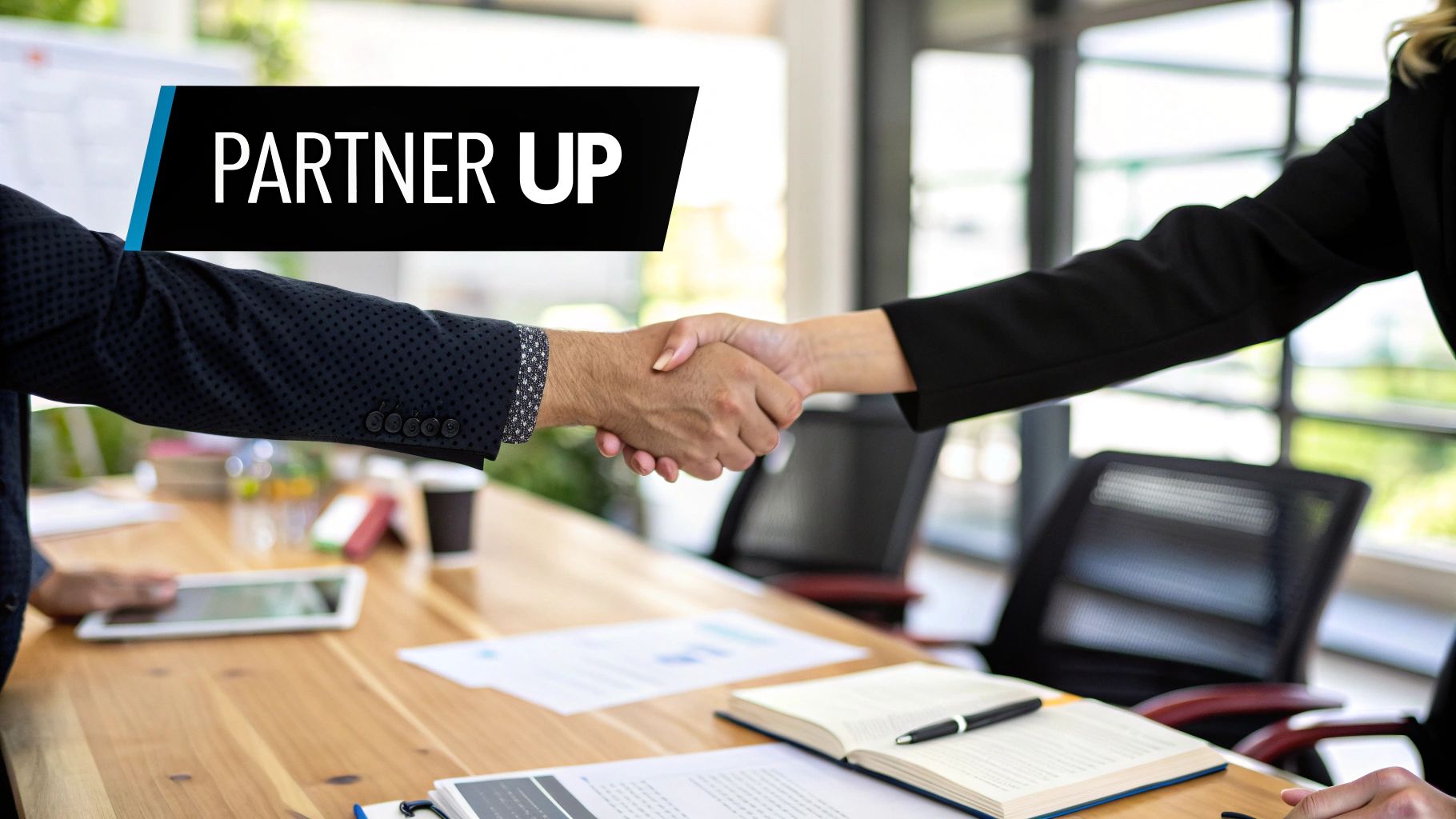
Forge Powerful Local Partnerships
One of the fastest ways to amplify your message is by teaming up with others who already have the trust of your ideal attendees. Think about where your audience spends their time and money locally, and start building bridges.
This isn't just about asking for a favor; it’s about creating a win-win scenario.
- Local Businesses: Offer a nearby café or bookstore a sponsorship spot. In return, they can put your flyers on their counter and mention you in their newsletter.
- Universities and Colleges: Connect with relevant departments or student clubs. They're often hungry for real-world networking opportunities for their members.
- Community Hubs: Think co-working spaces, libraries, and community centers. These are perfect spots for cross-promotion. You can even offer their members an exclusive discount to drive sign-ups.
Building these relationships is a cornerstone of effective local promotion. To really make these connections stick, you'll want to explore some proven https://creativize.net/blog/community-engagement-best-practices that can turn partners into true advocates.
Get Seen with Old-School Marketing
Never underestimate the impact of a well-placed flyer or poster. It might feel old-school, but physical marketing materials are incredibly effective at capturing attention in high-traffic areas where your audience naturally gathers.
The key is strategic distribution. Don't just blanket the town. Pinpoint the specific places your ideal attendees frequent and focus your efforts there. A poster for a tech meetup will do much better in a co-working space than at a community gym, for instance.
Pro Tip: Slap a QR code on all your physical materials that links directly to your event landing page. This bridges the gap between your offline and online efforts, making it dead simple for someone to register on the spot.
Connect with Local Media and Listings
Getting featured in local media lends your event a layer of credibility that’s hard to buy. Most towns have community calendars, local blogs, or radio shows that are always looking for content about what’s happening in the area.
Start by pulling together a list of these local outlets. To properly reach out, you need to craft a compelling announcement that gets people talking. Learning from these 8 Best Press Release Examples can show you how to structure a pitch that reporters will actually read and act on.
The importance of in-person connection is stronger than ever. In fact, a whopping 78% of organizers identify in-person events as their most impactful marketing channel. With 57% reporting increased foot traffic over the past year, it’s clear that building local, physical buzz is essential for a successful turnout. These stats from the 2025 State of Events Report just confirm what we already know: investing in local engagement is a seriously smart move.
Answering Your Top Event Promotion Questions
Juggling all the moving parts of event promotion can feel like a lot, especially when you're in the thick of it. To cut through the noise, I've rounded up some of the most common questions organizers ask, along with some straightforward advice to sharpen your strategy.
Think of this as a quick-reference guide for those practical, everyday hurdles you’ll hit while figuring out the best way to promote your event.
How Far in Advance Should I Start Promoting an Event?
This is the big one, and the honest answer is: it really depends on the scale of your event. There’s no single magic number, but a solid rule of thumb is to work backward from your event date.
For larger conferences, festivals, or anything that requires travel, you'll want to start the hype train four to six months in advance. This long runway is crucial for building momentum, rolling out early-bird pricing tiers, and giving people enough time to actually plan.
On the other hand, for smaller local events like a workshop or a community meetup, a six-to-eight-week promotional window is usually the sweet spot. It’s just enough time to generate real buzz without your audience losing steam or forgetting about it.
What Are the Best Low-Budget Event Promotion Tactics?
A tight budget doesn't mean you can't make a huge impact. It just means you have to be smarter and more creative with your efforts. The key is to lean into tactics that offer the biggest return on your time, not your money.
Here are a few of the most effective strategies I've seen work time and again:
- Go All-In on Organic Social: Create a unique event hashtag and consistently share valuable, non-salesy content. Get your speakers and partners to post, too—it taps into their networks for free amplification.
- Lean on Your Email List: Your email list is gold. It’s a direct line to an audience that has already said they want to hear from you. Use it to share exclusive updates and early announcements.
- Create Relevant Content: Write a few blog posts, whip up some short videos, or design an infographic related to your event’s theme. This stuff attracts organic traffic and positions your event as an authority.
- Find Your People (Strategic Partnerships): Team up with complementary brands, local influencers, or community groups. They can promote your event to their audience in exchange for tickets, a commission, or a simple cross-promotion.
How Can I Create Urgency to Drive Last-Minute Sales?
Ah, the final push. Urgency is an incredibly powerful psychological trigger that turns those "maybes" into ticket buyers. As the event gets closer, your messaging needs to shift and give people a compelling reason to act now.
FOMO—the Fear Of Missing Out—is your best friend in the final week of promotion. Your content should make people feel like they’ll be missing something truly special if they don't show up.
A great way to do this is to send out "Last Chance" emails right before a price jump or when a ticket tier is about to close. On social media, post countdowns and share some behind-the-scenes content of the setup. And if it's true, announcing that tickets are "almost sold out" is one of the most reliable ways to get procrastinators over the finish line.
At Creativize, we believe in the power of connection to drive success. Our platform helps businesses find the perfect local creative talent to make their projects, and their events, truly stand out. Discover how we can help you achieve your creative goals at https://creativize.net.

